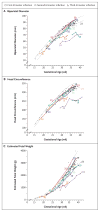Zika Virus Infection in Pregnant Women in Rio de Janeiro
- PMID: 26943629
- PMCID: PMC5323261
- DOI: 10.1056/NEJMoa1602412
Zika Virus Infection in Pregnant Women in Rio de Janeiro
Abstract
Background: Zika virus (ZIKV) has been linked to central nervous system malformations in fetuses. To characterize the spectrum of ZIKV disease in pregnant women and infants, we followed patients in Rio de Janeiro to describe clinical manifestations in mothers and repercussions of acute ZIKV infection in infants.
Methods: We enrolled pregnant women in whom a rash had developed within the previous 5 days and tested blood and urine specimens for ZIKV by reverse-transcriptase-polymerase-chain-reaction assays. We followed women prospectively to obtain data on pregnancy and infant outcomes.
Results: A total of 345 women were enrolled from September 2015 through May 2016; of these, 182 women (53%) tested positive for ZIKV in blood, urine, or both. The timing of acute ZIKV infection ranged from 6 to 39 weeks of gestation. Predominant maternal clinical features included a pruritic descending macular or maculopapular rash, arthralgias, conjunctival injection, and headache; 27% had fever (short-term and low-grade). By July 2016, a total of 134 ZIKV-affected pregnancies and 73 ZIKV-unaffected pregnancies had reached completion, with outcomes known for 125 ZIKV-affected and 61 ZIKV-unaffected pregnancies. Infection with chikungunya virus was identified in 42% of women without ZIKV infection versus 3% of women with ZIKV infection (P<0.001). Rates of fetal death were 7% in both groups; overall adverse outcomes were 46% among offspring of ZIKV-positive women versus 11.5% among offspring of ZIKV-negative women (P<0.001). Among 117 live infants born to 116 ZIKV-positive women, 42% were found to have grossly abnormal clinical or brain imaging findings or both, including 4 infants with microcephaly. Adverse outcomes were noted regardless of the trimester during which the women were infected with ZIKV (55% of pregnancies had adverse outcomes after maternal infection in the first trimester, 52% after infection in the second trimester, and 29% after infection in the third trimester).
Conclusions: Despite mild clinical symptoms in the mother, ZIKV infection during pregnancy is deleterious to the fetus and is associated with fetal death, fetal growth restriction, and a spectrum of central nervous system abnormalities. (Funded by Ministério da Saúde do Brasil and others.).
Conflict of interest statement
No potential conflict of interest relevant to this article was reported.
Figures




Comment in
-
Prospective cohort study of pregnant Brazilian women elucidates link between Zika virus infection and fetal abnormalities.Evid Based Med. 2016 Oct;21(5):193. doi: 10.1136/ebmed-2016-110476. Epub 2016 Aug 5. Evid Based Med. 2016. PMID: 27495823 No abstract available.
-
Monitoring and Preventing Congenital Zika Syndrome.N Engl J Med. 2016 Dec 15;375(24):2393-2394. doi: 10.1056/NEJMe1613368. Epub 2016 Dec 13. N Engl J Med. 2016. PMID: 27960068 No abstract available.
References
-
- Oliveira Melo AS, Malinger G, Ximenes R, Szejnfeld PO, Alves Sampaio S, Bispo de Filippis AM. Zika virus intrauterine infection causes fetal brain abnormality and microcephaly: tip of the iceberg? Ultrasound Obstet Gynecol. 2016;47:6–7. - PubMed
-
- Ventura CV, Maia M, Bravo-Filho V, Góis AL, Belfort R., Jr Zika virus in Brazil and macular atrophy in a child with microcephaly. Lancet. 2016;387:228. - PubMed
MeSH terms
Grants and funding
LinkOut - more resources
Full Text Sources
Other Literature Sources
Medical
